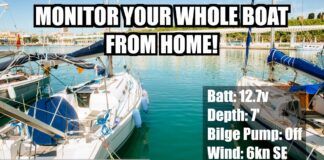
Any suggestions for an SSB-radio antenna installation on a 32-foot boat with a gaff rig and no backstay? Also, the hull ismild steel, and the standing rigging is galvanized wire, except the forestays, whichare stainless.
Morten Jensen-Hole
Tuatara, Wylo II
Long Island Sound, Conn.
In most cases of a backstay-less boat, wed recommend a transom-mount whip antenna. However, it looks like Tuatara doesn’t have much room on her transom for the antenna and the necessary standoff support bracket. If you could make room for a freestanding antenna, that would be ideal.
Although it would not be as efficient as a stern-mounted whip antenna, another possible option would be to install a sort of inverted V antenna, following the shrouds and using the mast as the top of the V. Unless youre well-versed in SSB installations, we suggest asking an installer about this method before deciding on it.
We consulted GAM Electronics Zachary Figoli (www.gamelectronicsinc.com) and Shakespeare Antenna Sales Manager Chris Catoe (www.shakespeare-marine.com) about your query. Figoli agreed that rigging an antenna from the shrouds would work, and he explained that some of his customers with catamarans have had success with this method.
Catoe suggested mounting the antenna alongside your cabinhouse, and then using a support bracket mounted higher up on the cabin (3 to 5 feet above the antennas base if possible).
Avoid running the antenna wire inside the mast. If there are other wires in there (VHF, lights, etc.), we don’t think they would play well together. Also, the wire shrouds could act like a faraday cage of sorts, reducing the SSBs RF output power.
Git Rot to halt rot
I have been looking at a 1981 Landfall 39, a double-ender with teak-on-plywood decks. I am worried about the deck, which appears solid but I already know has some rot in it. Is there a product that will seal the deck until we have time for a proper repair?
Dave and Sandra Brunk
Via email
Once rot gets into the wood, the spores will travel through it. George Buehler (www.georgebuehler.com), author of Buehlers Backyard Boatbuilding, describes using low-cost roofing products for sealing new wooden decks, but it seems unlikely that sealing the teak (easier said than done) is going to buy you much time in this case.
One option he suggested was to remove the teak over the suspected rotten sections, and then stiffen the plywood by using the drill-and-fill method described in boat repair books. West Systems Fiberglass Boat Repair and Maintenance publication (free online) describes this method using its products. Buehler suggests two-part BoatLife Git Rot (www.boatlife.com), and weve had good luck with Smith & Co.s Fill-it Epoxy Filler (www.smithandcompany.org). Since removing the teak is half the battle, replacing the plywood here makes more sense to us. There is no easy fix that retains the decks original structural properties.






































